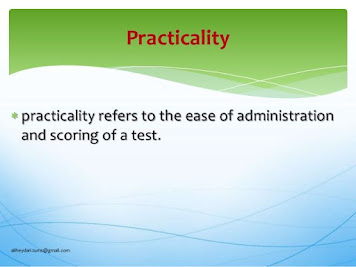A Characteristic Of a Good Test
Testing is an essential component of education, psychology, and professional assessments. A well-designed test must meet several criteria to be considered effective, including validity, reliability, fairness, and practicality/usability. Among these, practicality and usability are often overlooked but play a crucial role in determining whether a test can be efficiently administered and interpreted.
This blog post explores practicality and usability as key characteristics of a good test, discussing their importance, key elements, and strategies for improvement.
Understanding Practicality and Usability in Testing
What is Practicality?
Practicality refers to the logistical feasibility of a test—how easily it can be administered, scored, and interpreted within given constraints (time, cost, resources).
What is Usability?
Usability focuses on the user experience—how intuitive and accessible the test is for both administrators and test-takers.
Differences Between Practicality and Usability
| Aspect | Practicality | Usability |
|---|---|---|
| Focus | Logistics & efficiency | User experience & accessibility |
| Key Concern | Cost, time, resources | Clarity, ease of use |
| Example | Automated scoring | Clear instructions |
Why Practicality and Usability Matter in Assessments
A test may be valid and reliable, but if it’s too complex or expensive to administer, its effectiveness diminishes.
Benefits of Practical and Usable Tests:
✔ Cost-effective – Reduces unnecessary expenses.
✔ Time-efficient – Faster administration and scoring.
✔ Higher compliance – Easier for test-takers to engage.
✔ Better accuracy – Clear instructions reduce errors.
Key Elements of a Practical and Usable Test
A. Administration Ease
Simple instructions
Minimal supervision required
B. Scoring Efficiency
Automated or streamlined scoring
Clear rubrics
C. Time Management
Reasonable completion time
Balanced question distribution
D. Cost-Effectiveness
Affordable materials
Digital options to reduce printing
E. Accessibility
Multilingual support
Adaptable for disabilities
How to Improve Test Practicality and Usability?
1. Use Technology
Online testing platforms (e.g., Google Forms, LMS-integrated quizzes).
AI-based scoring for essays.
2. Simplify Instructions
Avoid jargon.
Provide examples.
3. Pilot Testing
Gather feedback from test-takers.
Adjust based on real-world use.
4. Optimize Question Formats
Mix MCQs, short answers, and interactive tasks.
Avoid overly complex wording.
Examples of Practical and Usable Tests
A. Standardized Tests (SAT, GRE)
Computer-adaptive formats.
Instant scoring for some sections.
B. Employee Skill Assessments
Gamified quizzes.
Automated result generation.
C. Classroom Quizzes
Google Forms with auto-grading.
Peer-reviewed assignments.
Importance of the practicality of a test
Limitations
Challenges in Ensuring Test Practicality and Usability
❌ Budget constraints – High-tech solutions may be costly.
❌ Resistance to change – Traditional educators may prefer paper tests.
❌ Diverse test-taker needs – Accessibility can be complex.
Future Trends in Test Design for Better Usability
🔹 AI-Powered Assessments – Adaptive testing.
🔹 Virtual Reality (VR) Testing – Simulated environments.
🔹 Blockchain for Security – Tamper-proof certifications.
Conclusion
Practicality and usability are critical for creating effective tests. By focusing on ease of use, cost-efficiency, and accessibility, educators and organizations can develop assessments that are not only valid and reliable but also feasible and user-friendly.
FAQs
Q1: What is the difference between practicality and usability in testing?
A: Practicality deals with logistical feasibility (cost, time), while usability focuses on user experience (clarity, accessibility).
Q2: How can technology improve test practicality?
A: Digital platforms enable automated scoring, remote proctoring, and instant feedback.
Q3: Why do some tests fail in usability?
A: Poor instructions, overly complex formats, or lack of accessibility features can reduce usability.
Q4: Can a test be practical but not usable?
A: Yes—if it’s easy to administer but confusing for test-takers, it lacks usability.
Q5: What are some cost-effective ways to enhance test usability?
A: Using free online tools (Google Forms), simplifying language, and pilot testing.
Note:
Plz must visit my other Apps & Tech Websites for more information below here.





Excellent post and wonderful blog, this sort of interesting posts I really like, keep it up... Design Sprint Tool
ReplyDelete